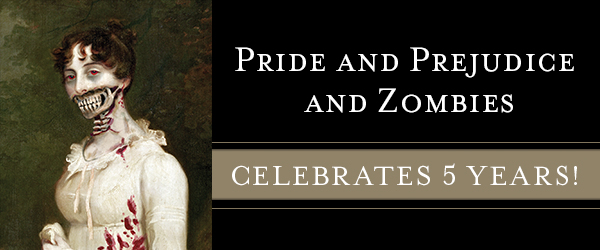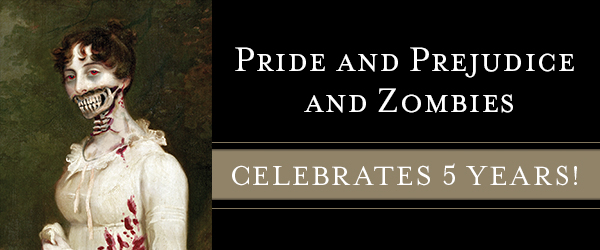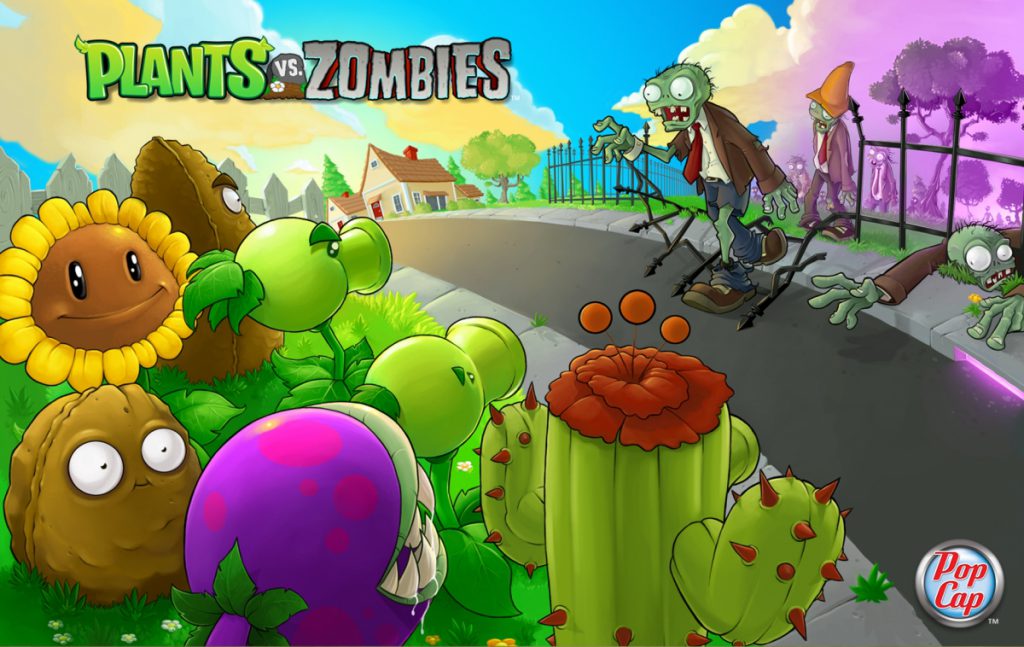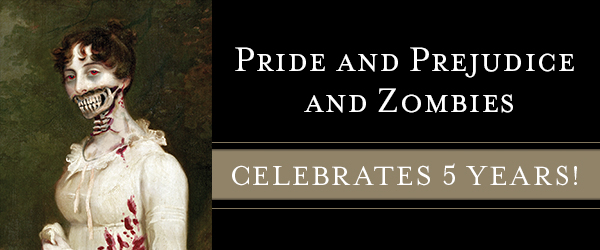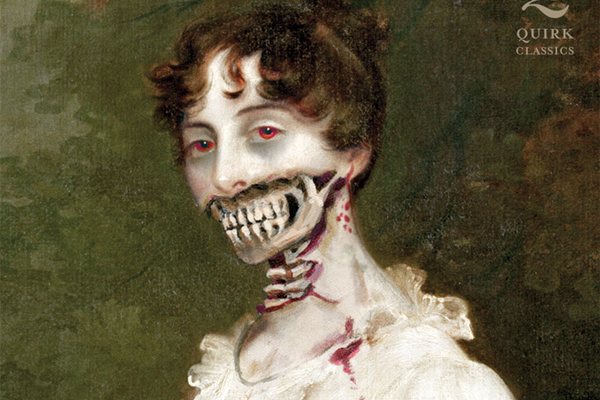Pride & Prejudice & Zombies: Part 1 of 3
[Ed. Note: To celebrate the five year anniversary of Pride & Prejudice & Zombies by Seth Grahame-Smith, Quirk will be hosting a number of PPZ related articles, giveaways, and editorials. This first piece, from frequent contributor Thom Dunn, is the first in a three part essay on the creation of Pride & Prejudice & Zombies, and Quirk's move to start publishing fiction. Enjoy! – Eric]
Back in 2009, vampires were still the "it" monster of the time, and Quirk Books, a small independent publisher out of Philadelphia founded in 2002, had done very little in terms of fiction books. In fact, when the company was founded, they were focused on everything but fiction. Non-fiction, novelty, and coffee table books were their wheelhouse, with “strikingly unconventional” topics and packages to amuse, entertain, and inform. The little publishing house had already put out some pretty big books, such as the “Worst Case Scenario” series, but Quirk Editor Jason Rekulak had always wanted to tell a different kind of story.
Quirk’s fiction output had been limited to a few Choose-Your-Own-Adventure parodies and several licensed interactive books — stories based on Batman and CSI that featured some kind of multimedia element. But Rekulak still had an itch to publish fiction — after all, that was a huge potential audience that they were missing out on. (At one point, Rekulak had been playing around with the idea of re-telling classic stories like Austen with monkeys, but, well, that never…evolved, as it were)
Around this same time, the Internet had come into its own as a creative space for storytellers. People had begun to explore the limits of derivative works, throwing together previously unrelated aesthetics and topics and finding an audience. These “mashups” (works created by combining two or more disparate things into a singular new work) were wildly popular, but when it came to copyright, they were a huge gray area. As long as the final product is arguably “transformative,” it’s still legal (or at least, no explicitly illegal) for it to exist. Still, even pre-Internet, the practice was fairly well-established as a subgenre of videos and music (think of classic hip-hop DJs sampling tracks). But a “literary mashup?” No such thing — and definitely not on a commercial or mainstream scale.
It was video mashups on YouTube that got Rekulak thinking: how could Quirk apply this same culture-clash idea to books? The first issue was finding works that were usable for a commercial remix (i.e., things without copyright). Rekulak compiled what he referred to as a “Takeout Menu” of public domain texts, and a second list of funny/weird things to mash them with. Then it was just a question of mixing and matching: War & Peace & Dinosaurs…nope…A Tale Of Two Ninja Cities…ehhhh…The Legend of Sleepy Hollow + The Four Horsemen of the Apocalypse…still too desperate.
Then he hit on Pride & Prejudice & Zombies. And that was it. "Once I had the title, I knew. I knew exactly what the book was going to be. And I just really wanted to read it!" said Rekulak.
#

Quirk had a well of freelance writing talent to pull from, but when it came to Pride & Prejudice & Zombies, they knew exactly where to turn: Seth Grahame-Smith, a then-32-year-old aspiring screenwriter in Los Angeles. Four years earlier, Grahame-Smith had pitched a book to Quirk that never quite panned out. The book wasn't right for the company at the time, but his voice was clever and unique in that Quirk-y way, so Jason Rekulak kept in touch with him for various work-for-hire gigs. By the time the idea for Pride & Prejudice & Zombies came to light, Grahame-Smith had already written several books for Quirk, including The Spider-Man Handbook, The Big Book of Porn, and, perhaps most importantly, How to Survive a Horror Movie, which zipped with Grahame-Smith’s quick wit and cemented him as an expert in horror genre tropes. At that point, his relationship with Quirk had existed entirely over the phone. “He [Jason] called me one day, out of the blue, very excitedly, and he said, ‘All I have is this title, and I can’t stop thinking about this title.’ And he said: ‘Pride and Prejudice and Zombies.’ For whatever reason, it just struck me as the most brilliant thing I’d ever heard,” said Grahame-Smith.
Grahame-Smith immediately went back and re-read the Jane Austen novel, which he hadn’t touched since he was about fourteen. Like many 14-year-old boys, he hadn’t not particularly cared for Elizabeth Bennet’s love life and Regency mannerisms, and nor for Austen’s 19th-century prose, on his first readthrough. But as he combed through text, marking notes in the margins about what he could change and where he could insert a shambling undead horde to add dramatic tension, Grahame-Smith genuinely began to understand the power and appeal of Austen’s work, “how brilliantly constructed it is, how full the characters are, and most importantly, how sarcastic and even a little mean-spirited Austen was in tearing down the conventions that she disapproved of."
As he worked through the book, Grahame-Smith began making more and more connections between the seemingly incongruous worlds of zombie attacks and English aristocracy. “You have little details everywhere, like the fact that there are soldiers encamped near Meryton in the original book, for seemingly no reason whatsoever. There’s just this huge regiment of soldiers there, and the obvious thing to do in this case is to say that, well, they’re there digging up graves and burning bodies and fighting the unmentionable menace,” he said. It’s almost as if Jane Austen was subconsciously setting us up for this. You have this sharp-tongued, fiercely independent heroine. It’s not a huge leap to say she’s a sharp-daggered, fiercely independent heroine. And you have Darcy, on the other side, who’s a pompous and privileged guy. And you say, all right, he’s a pompous and privileged slayer. And that’s how they battle it out with each other.”
From there, Grahame-Smith pasted the text of the original Pride & Prejudice into a document on his computer, and began adding in scenes and details — with his font colored red, of course — to flesh out this alternate history world full of “Unmentionables” and ninja swords. While the frequency of characters taking long strolls and carriage rides offered ample opportunity for zombie attacks, Grahame-Smith also understood the importance of keeping the stakes high at the center of the story; in true zombie story fashion, no one character was safe beyond the central protagonist. “If you kill someone in Chapter 7, it has repercussions in Chapter 56,” he noted. Still, he was wary to stray too far from the original text. “I didn’t want to mess with Jane Austen’s overall structure, because it’s a masterpiece. Who am I to screw with one of the most brilliantly plotted novels of all time?” Grahame-Smith’s two-colored text was an excellent visual aide in balancing out the zombie details with Austen’s luscious prose, and the book ultimately retained about 85% of the original text — plus a few gruesome character deaths for good measure.
#
On the surface, there is nothing contemporary — and certainly nothing technological — about inserting mindless undead creatures into a two hundred year-old book. But Pride & Prejudice & Zombies is in many ways a true a post-postmodern text, one that owes much of its existence and success to the Internet. Sure, there had been plenty of books before it that had revisited or repurposed existing popular stories in the name of deconstruction. But instead of taking cues from Thomas Pynchon, Pride & Prejudice & Zombies basically sprung out of YouTube: a “literary mashup.”
Semantics aside, it was clear from a very early stage that Quirk had a hit on their hands. The pre-release hype alone was nearly unprecedented; this was during a time when smartphones were becoming standard-issue, and the new social media whirlwind helped the word-of-mouth go viral. All it took was the opening lines of the book — “It is a truth universally acknowledged, that a zombie in possession of brains must be in want of more brains” — and a zombified portrait of a Regency-era woman to set the Internet aflame. A viral outbreak of genre mashups soon spread across the publishing field faster than a zombie outbreak — so much so that Quirk bumped Pride & Prejudice & Zombie’s release date up by two months to meet reader demand (and capitalize on the hype).
#
Still, in era when online crazes come and go in the blink of an eye, it’s remarkable that a two hundred year old book could cause so much of a stir. “People love Jane Austen," said Rekulak. "They love that book in a way they don't love other books. Austen fans are a special bunch. If there's a more loved novel in the English language, I don't know it. It's the template for so many stories, like a Rosetta Stone of Hollywood rom-coms."
The inner turmoil of Austen’s characters has always been universal — the way they grapple with sexuality, selfishness, swagger, and satisfaction — the addition of zombies provided an opportunity to externalize those conflicts. “Instead of taking herself in hand, the heroine now battles an actual monster,” noted Matthew Kaiser, an assistant professor of 19th century literature at Harvard University. “In literature, monsters are always projections of our own hidden impulses.”
Quirk was hit upon the perfect curveball element to juxtapose with Austen’s popularity. At the time, vampires were still very much the “in” monster of choice. The zombie craze was just over the horizon, but Quirk’s decision to use zombies had less to do with any carefully calculated sociological futurism, and more with the fact that, well, zombies were cool. To them, anyway. And pretty much no one else. “Growing up, I was always big into zombies,” said Rekulak. “Especially the George Romero films. I loved those. Now, five years later, zombie jokes aren’t as fresh. But we used to make zombie jokes in the office and socially all the time. It wasn’t that it was cool or anything. It was just what we talked about, something we always liked.”
Sociologists and media critics alike have theorized about the ways that popular monsters reflect our collective cultural fears. Quirk may have had a long-standing, genuine appreciation for zombies, but their breakout as lumbering harbingers of the cultural zeitgeist makes a lot of sense in the post-Bush wake of the 2008 financial crash. “Since the '20s, when White Zombie came out, and in the 1960s, with the Romero movies, zombies have always been an easy metaphor for whatever ills society finds itself up against,” observed author Seth Grahame-Smith. “They've been used to represent everything from rampant consumerism to the spread of communism. We live in an age when it's very easy to be afraid of everything that's going on in the world. There are these large groups of faceless people somewhere in the world, who mean to do us harm, and cannot be reasoned with. Zombies are sort of familiar territory.”
Cultural fears and absurd juxtapositions aside, Pride & Prejudice & Zombies still wouldn’t have worked if the elements hadn’t meshed. While our modern society might be far removed from Austen’s proper English setting (and even further removed, perhaps, from Grahame-Smith’s proper-English-setting-with-ninjas), the author discovered an even greater relevance to zombies as he worked on the book. “People realize that zombies are likable villains. You have sympathy for them. Zombies haven't chosen to be horrible. They've been infected, and now they're sort of doomed to walk the earth with this singular purpose of seeking out and infecting other people. So there's something tragic about them. And then of course there's something funny about them. They're stupid. They're so helpless […] That was what was so funny to me about this idea, is the fact that these people in Austen's books are kind of like zombies. They live in this bubble of extreme wealth and privilege, and they're so preoccupied with the little trivial nothings of their lives. As long as there's enough lamb for the dinner table, they could care less what's falling apart around them. So in this book, in this version, it literally is falling apart around them, and they sort of carry on writing letters to each other about hurt feelings and loves and passions and all these things.” Brad Pasanek, an 18th-century literature specialist at the University of Virginia, agreed, saying of the original novel that “The characters other than the protagonist are so often surrounded by people who aren’t fully human, like machines that keep repeating the same things over and over again. All those characters shuffling in and out of scenes, always frustrating the protagonists. It’s a crowded but eerie landscape. What’s wrong with those people? They don’t dance well but move in jerky fits. Oh, they are headed this way!"
#
As for the ninja elements, and why they worked out so well? I like to think that’s self-explanatory.
#

Within a week of its release on April 1, 2009, Pride & Prejudice & Zombies shot to #3 on The New York Times Bestseller list — not bad for a book with an initial print run of just 12,000 — and the bidding war for movie rights grew fierce before the book ever hit the stands. Even the critical response was overwhelmingly positive, and while its success could certainly be credited in part to Austen’s long-running popularity, Grahame-Smith’s contributions received their own share of accolades. According to The AV Club, “Grahame-Smith’s amendments add some interest, pathos, and essential motivation to Austen’s subplots…[He] simplifies Austen’s complex verbiage to a degree, but retains her enchanting style and vocabulary. When he politely turns the focus to ultraviolent mayhem—at one point, Elizabeth strangles one ninja with his own entrails and takes a bite from the fresh heart of another—the transition takes place with polished seamlessness. Such is the accomplishment of Pride & Prejudice & Zombies that after reveling in its timeless intrigue, it’s difficult to remember how Austen’s novel got along without the undead.” Entertainment Weekly went on to say, “The greater achievement of the book may lie in the satisfying desire it awakens to read the remix and the original side by side. Indeed, you'll miss out if you do not, so smartly does young Mr. Grahame-Smith insert himself in the thicket of curlicued manners that is Miss Austen's real comic theme.”
Quirk’s unconventional foray into fiction was successful, but all the media attention they received created pressure to repeat the success. The days of brainstorming phone calls were over; in the lightning-fast world of online trends, the publisher had to put out another book fast or risk losing steam. But even when picking up the publishing pace, Quirk knew (wisely) they couldn’t just pump out a pale imitation — whatever they did for a followup, they had a serious standard to maintain. Still, if they didn’t do it fast, then someone else certainly would: the infection was spreading. Public domain classics were snapped up and remixed, and mindless, shambling imitations from other companies began to flood the market (after all, it’s hard to make a claim of intellectual property when you’re already repurposing an existing text). Quirk knew they had a captive and hungry audience, but they weren’t exactly sure which part of Pride & Prejudice & Zombies they hungered for. Was it brains? Was it blood? Or was it just a chance to revisit that irresistible Austen charm?
Meanwhile, in the wake of his success, Seth Grahame-Smith received an irresistible offer from Grand Central Publishing for what would become Abraham Lincoln: Vampire Hunter, which meant that he’d be unavailable for the followup. Editor Jason Rekulak turned to his network of writers and literary agents and opened himself up to proposals for their next mashup project. A veritable legion of zombies authors jumped at the chance to have their pitches heard and hopefully hop on that mashup train to whatever cashcow it might lead them to. But as irreverent an idea as the burgeoning series was, it needed a seriously good writer to deliver on the product.
Quirk ultimately found their savior in the most unlikely of places: in an apartment that was literally across the street from their office.
-#-
